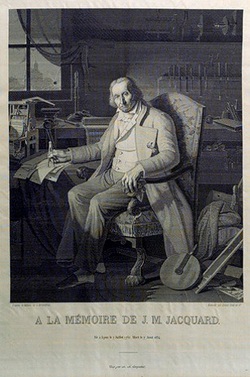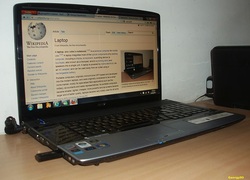 In 1801, Joseph Marie Jacquard, a French weaver and merchant, made an improvement to the textile loom, a device used to weave cloth. This is by introducing a series of punched paper cards (“IBM/Hollerith card”), a piece of stiff paper that contains digital information represented by the presence or absence of holes in predefined positions, as a template which allowed his loom to weave intricate patterns automatically. The resulting Jacquard loom was an important step in the development of computers because the use of punched cards to define woven patterns can be viewed as an early, albeit limited, form of programmability. It was the fusion of automatic calculation with programmability that produced the first recognizable importers. In 1837, Charles Babbage, FRS, an English mathematician, philosopher, inventor and mechanical engineer, originated and designed the concept of a programmable mechanical computer, built from mechanical components such as levers and gears, rather than electronic components--his analytical engine. Limited faces and Babbage’s inability to resist tinkering with the design meant that the device was never completed--nevertheless his son, Henry Babbage, completed a simplified version of the analytical engine’s computing unit (the “mill”) in 1888. He gave a successful demonstration of its use in computing tables in 1906. In 1910, this machine was given to the Science museum, one of the three major museums on Exhibition Road, South Kensington, London, in the Royal Borough of Kensington and Chelsea.In the late 1880s, Herman Hollerith, an American statistician who developed a mechanical tabulator based in punched cards to rapidly tabulate statistics from millions of pieces of data, invented the recording of data on a machine-readable medium. Earlier uses of machine-readable media had been for control, not data. “After some initial trials with paper tape, he settled on punched cards...”; punched/perforated paper tape is a form of data storage, consisting of a long strip in which holes are punched to store data. To process these punched cards he invented the tabulator, or “tabulating machine,” an electrical device designed to assist in summarizing information and, alter, accounting; and the keypunch machines, devices used for the purpose of entering data onto punch cards by precisely punching holes in the cards at specific locations as determined by the keys struck by the operator. These three inventions were the foundation of the modern information processing industry. Large-scale automated data processing of punched cards was performed for the Eleventh United States Census, taken June 2, 1890, by Hollerith's company, which later became the core of IBM, or the “International Business Machines Corporation,” an American multinational technology and consulting corporation, with headquarters in Armonk, New York, United States. By the end of 19th century, a number of ideas and technologies, that would later prove useful in the realization of practical computers, had begun to appear: Boolean algebra (or “Boolean logic”), a logical calculus of truth values, developed by George Boole in the 1840s; the vacuum tube (“electron tube” (North America), “thermionic valve,” or “valve”) which in electronics is a device controlling electric current through a vacuum in a sealed container; punched cards and tape; and the teleprinter (“teletypewriter,” “Teletype” or “TTY”), an electro mechanical typewriter that can be used to send and received typed messages from point to point and point to multipoint over various types of communications channels. See: Internet On Satellite Broadband
 A computer is a general purpose device that can be programmed--a “computer program (also “software,” or just a “program”) is a sequence of instructions written to perform a specified task with a computer--to carry out a finite set of arithmetic or logical operations. Since a sequence of operations can be readily changed, the computer can solve more than one kind of problem.Conventionally, a computer consists of at least one processing element and some form of memory, which in computing, refers to the physical devices used to store programs or sequences of instructions) or data (e.g. program state information) on a temporary or permanent basis for use on a computer or other digital electronic device.The processing element carries out arithmetic and logic operations and a sequencing and control unit that can change the order of operations based on stored information. Peripheral devices allow information to be retrieved from an external source, and the result of operations saved and retrieved. The first electronic digital (data technology that uses discrete (discontinuous) values) computers were developed between 1940 and 1945 in the United Kingdom and United States. Originally, they were the size of a large room, consuming as much power as several modern personal computers (PCs). In this era, mechanical analog computers, a form of computer that uses the continuously changeable aspects of physical phenomena such as electrical, mechanical, or hydraulic quantities to model the problem being solved, were used for military applications.
Modern computers based on integrated circuits, or “monolithic integrated circuit” (also referred to as “IC,” “chip,” or “microchip”) is an electronic circuit manufactured by lithography, or the patterned diffusion of trace elements into the surface of a thin substrate of semiconductor material, are millions to billions of times more capable than the early machines. And also, occupy a fraction of the space.
Simple computers are small enough to fit into: mobile devices (also known as “handheld device,” handheld computer” or simply “handheld”), a small, hand-held computing device, typically having a display screen with touch input and/or a miniature keyboard and weighing less than two pounds (0.91 kg); and mobile computers, human-computer interaction by which a computer is expected to be transported during normal; usage. Both of them can be powered by small batteries, which in electricity, is a device consisting of one or more electrochemical cells that convert stored chemical energy into electrical energy.
Personal computers in their various forms are icons, or the “religious work of art, most commonly a painting, from Early christianity and in certain Eastern Catholic churches, of the Information Age, a period that will be characterized by the ability of individuals to transfer information freely, and to have instant access to information that would have been difficult or impossible to find previously. They are what most people think of as “computers.” However, the embedded computers, or computer systems designed for specific control functions within a larger system, often with real-time computing constraints, found in many devices from: mp3 players (“portable media players (“PMP”), or “digital audio player” (“DAP”), a consumer electronics device that is capable of storing and playing digital media such as audio, images, video, documents, etc. the data is typically stored on a hard drive, microdrive, or flash memory; to fighter aircraft, a military aircraft designed primarily for air-to-air combat against other aircraft, as opposed to bombers and attack aircraft, whose main mission is to attack ground targets; and from toys to industrial robots, defined by ISO, as an “automatically controlled, reprogrammable, multipurpose manipulator programmable in three or more axes,” are the most numerous. See: Satellite Internet/Broadband
|


 RSS Feed
RSS Feed